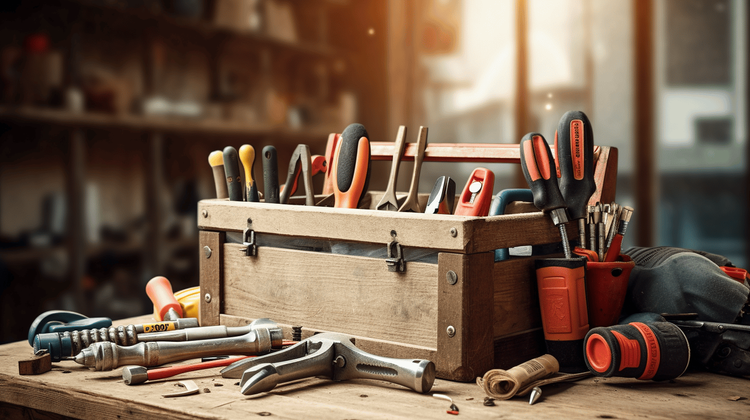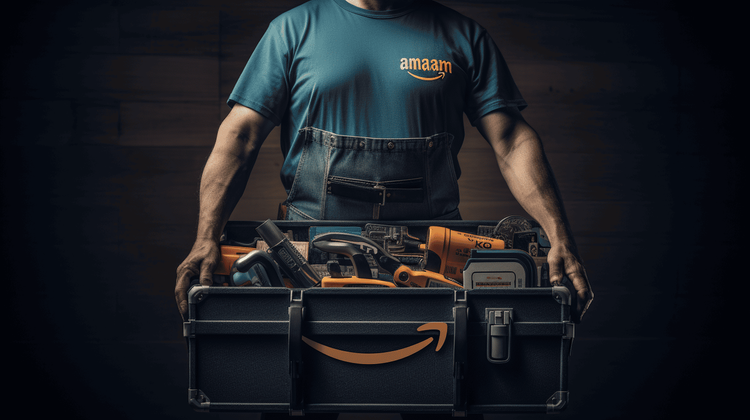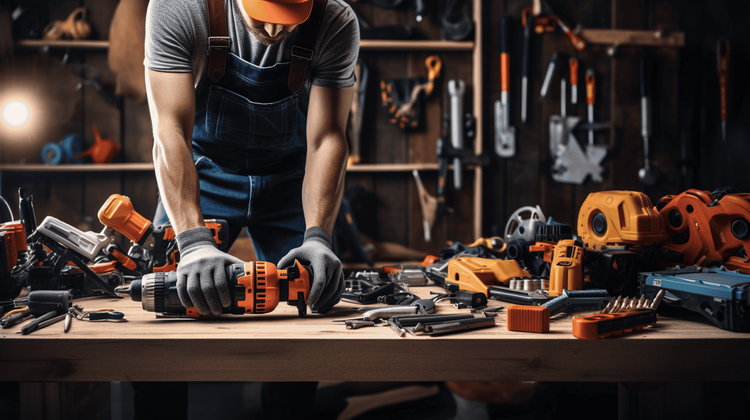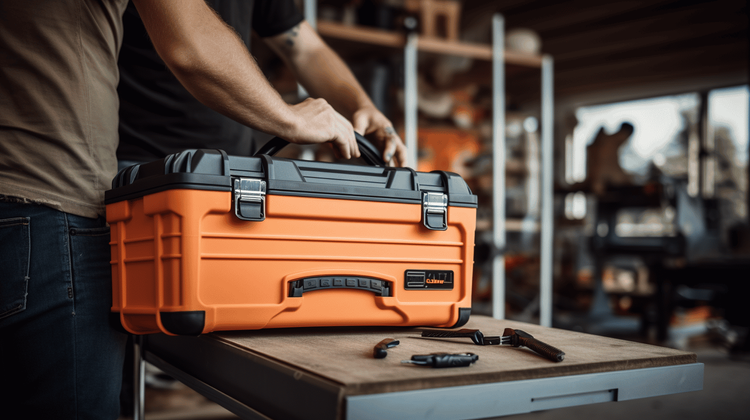Demystifying the Hunt for Budget-Friendly Tools for DIY Enthusiasts
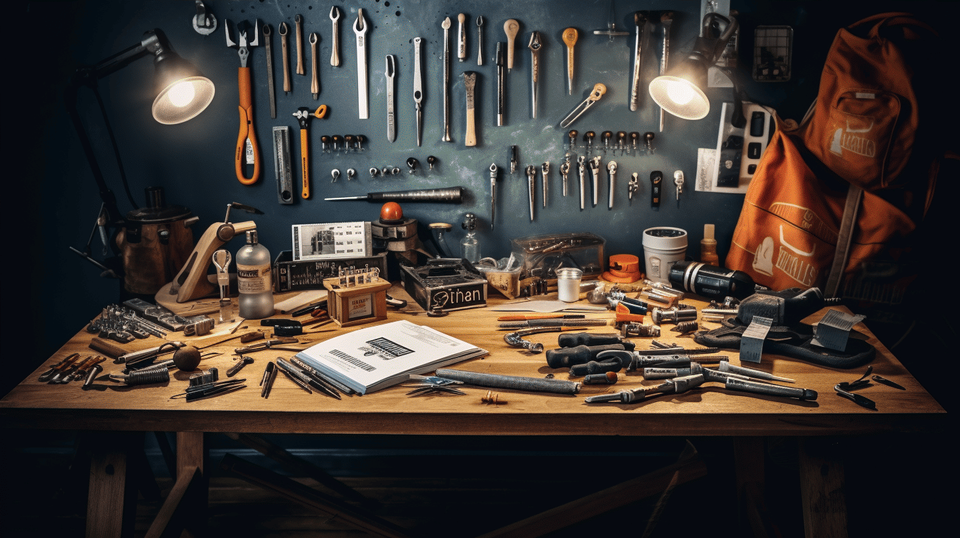
Hello DIY enthusiasts! 🛠 Has your passion for do-it-yourself (DIY) projects escalated but your budget is feeling a pinch? Well, we've got some fantastic news for you! No longer is the world of DIY tools exclusive to the extravagant spenders or professional tool hoarders. You can now match your passion for DIY projects with an arsenal of surprisingly affordable yet sophisticated tools.
This article will unmask the myth that budget-friendly tools fall shy of their extravagant counterparts in functionality and durability. Plus, we'll reveal where these affordable treasures are hidden. From the familiar aisles of local hardware stores, the vast expanse of online marketplaces, to the rustic charm of garage sales and beyond. Let's dive in and start upping your DIY game without breaking the bank! 💸💪😉
Now, sit back, grab a cup of tea, coffee, or your favorite beverage - and let's get into the nitty-gritty of mastering the art of finding the perfect cost-effective tools for your DIY toolkit. Buckle up for an informative ride and remember, the keyword throughout our journey is balance - Balance between quality and cost, tool longevity, safety precautions, and more. Let's get started!
Whether you're an ardent DIY enthusiast or an occasional home fixer, there's no denying that possessing the right tools for your projects can make a tremendous difference. From enhancing efficiency and precision to improving safety and project longevity, the correct tools can elevate your DIY experience and quite possibly, the quality of your finished projects.
Efficiency and Precision
For any DIY project, time is of the essence. Using the correct tools can help to drastically increase the speed and accuracy of your work, allowing you to complete your tasks efficiently. For instance, imagine trying to assemble a bookshelf with merely a hand screwdriver. While technically feasible, a powered drill would unmistakably make the task quicker and more precise. Not only does this save time, but it also saves you from unnecessary fatigue. Tools are designed with specific purpose in mind - leverage it!
Safety Considerations
Perhaps even more critical than efficiency is safety. Utilising the appropriate tools for your DIY tasks can mitigate the risk of accidents and injuries. For example, using a sturdy ladder rather than improvising with a high countered-stool when painting a ceiling. Proper safety gear, like protective gloves, goggles, or earmuffs, should be considered part of your toolbox as well. After all, safety should never be compromised when it comes to DIY projects.
Longevity of the Project
Remember earlier when we mentioned the power drill and the bookshelf assembly? Let’s return to that. Imagine that the screws aren’t secured tightly because a hand screwdriver was used instead of a drill. Over time, that bookshelf is likely to wobble, risking the longevity of your project. The right tools can ensure a sturdy and lasting outcome, enhancing the durability and lifespan of your creations.
Skill Enhancement
Lastly, having the right tools can also facilitate the enhancement and expansion of your skill set. Mastering a range of tools broadens your capabilities, allowing you to tackle a variety of DIY projects. Moreover, as you become adept at using professional-standard equipment, you may find that your DIY projects resemble the quality of expert workmanship— a remarkable achievement for any hobbyist!
So next time you undertake a DIY project, ensure you're equipped with the right tools. Not only will this amplify your efficiency and precision, but it will also significantly heighten safety, prolong the project's longevity, and advance your skill set. Happy DIY-ing! 😄
In the grand arena of tool shopping, there's a perennial debate that continues to baffle buyers: Should I go for budget-friendly or expensive tools?🔨💰 This dilemma probably haunts everyone that is about to make a significant investment in their tool collection. Understanding the pros and cons of these two distinct paths is crucial, and that's exactly what we'll be delving into right now. 🧐
Initial Investment
When it comes to the initial cost, budget-friendly tools definitely win the race. After all, the term "budget-friendly" itself implies a lower price tag. They provide an opportunity for hobbyists, DIY enthusiasts, and even small-scale professionals to acquire necessary equipment without burning a hole in the pocket.
On the other hand, expensive tools are termed "expensive" for a reason. However, it's important to note, these tools often come with a promise of superior quality, enhanced functionality, and often, a better warranty program.
- Budget-friendly Tools 💰: Lower upfront costs, suitable for non-intensive usage
- Expensive Tools 💸: Higher upfront costs, often justified by superior quality and extended warranties
Life-span and Durability
In terms of life-span and durability, expensive tools generally fare better. They are designed with high-quality materials and advanced manufacturing techniques. This makes them more resistant to wear and tear, ensuring that these tools are the workhorses that keep on going. 🏇
Budget-friendly tools, though initially seeming cost-effective, could potentially have shorter lifespans. In the long run, you might end up spending more on replacements.
- Budget-friendly Tools 🔄: Lower life-span, higher replacement frequency
- Expensive Tools 🐢: Long-lasting, more wear and tear resistant
Performance and Features
Admit it, who doesn't enjoy extra features and superior performance? 🚀Expensive tools often dish out amazing performance, increased efficiency, and features like advanced controls and precision. For professionals, these attributes can justify the high upfront costs.
While budget-friendly tools offer necessary functionalities, they might lack in the bells and whistles that expensive counterparts provide. But, they still do their job well enough for basic requirements.
- Budget-friendly Tools 🧰: Basic functionalities, limited features
- Expensive Tools 🕹️: Superior performance, advanced features
Maintenance and Repair Costs
The cost of maintaining and repairing tools can be a deciding factor, too. Budget-friendly tools might not hold up well under intensive use, leading to more frequent repairs. And often, cheaper tools come with limited or no warranty.
With their robust build and typically comprehensive warranties, expensive tools could save you money in the long haul, reducing frequent maintenance and repair costs.
- Budget-friendly Tools 🛠️: More frequent repairs, lesser warranty provisions
- Expensive Tools 🏥: Less frequent repairs, better warranty provisions
As you weigh your tool options, remember that both budget-friendly and expensive tools have their places. If you're a DIY enthusiast or a hobbyist, budget-friendly tools might be just the ticket. But for professional, heavy-duty usage, shelling out some extra cash for expensive tools could be a healthier investment in the long run. Just be sure to carefully evaluate your needs, budget, and expectations before making your purchase. 😎
When diving into a new project or purchase, it's a common dilemma to juggle between cost and quality. We all want the highest quality at the least possible expense, right? But striking the right balance can be like dancing on a tightrope. You don’t want to compromise on quality, yet your budget looms large. So, how do we solve this mystery? Is there a magic formula, or is it simply a stroke of good luck?
The answer lies in carefully assessing two primary aspects: understanding what quality means to you, and knowing your budget constraints. Here's a closer look at what these mean:
- Understanding Quality: Different people have varying perceptions of quality. For some, it could mean top-of-the-line luxury products while others might prioritize functionality over glamour. Understanding your personal definition of quality is the key to avoiding over-spending on aspects that might not add value to you.
- Budget Consciousness: Having a clear grasp of your budget helps to eliminate options that are out of your financial reach. Being aware of your budget does not necessarily mean skimping on quality. Instead, it enables you to focus on optimizing the value you can get for your available resources.
It’s all about balancing the scale according to your specific needs, isn’t it? 🤔 When you understand precisely what you’re looking for and exactly how much you’re willing to spend, you can seamlessly align cost and quality.
One might argue that affordable items are always going to be of inferior quality. But it’s worth noting that sometimes it is possible to find products or services that aren't exorbitantly priced but still offer a decent level of quality. Therefore, in the ultimate battle between cost and quality, the winner isn’t just about choosing the cheapest or the most expensive. It's about finding a harmonious balance where you get value for your money without going into debt.
Armed with these insights, remember, even on a frugal budget, “inexpensive” doesn’t have to mean “cheap quality.” And “expensive” doesn’t have to extend beyond your means. So, next time you're faced with a choice, remember this balancing act, and make an informed decision! 👍
Everyone loves a good fixer-upper project, but what if you're on a tight budget? No worries! There are plenty of places where you can find quality tools at budget-friendly prices. Whether you're looking for a power drill or a basic screwdriver, these places have got you covered. So, let's dive right into the sea of savings, shall we? 😊
Online Marketplaces
Dominating the first spot on our list is none other than online marketplaces 🌐. Websites like eBay, Craigslist, and Amazon often feature used or second-hand tools that are much cheaper than their brand-new counterparts.
- User reviews can be a useful resource when choosing a product.
- Keep an eye out for deals and discounts. Your dream tool may just be on sale!
- Be sure to scrutinize product pictures and descriptions, as well as the seller's return policy.
These days, safety and quality are both possible—even when shopping online—when you know what to look for.
Local Hardware Stores
Don't underestimate the power of small, local hardware stores 🛠️. These hidden gems often offer quality tools at reasonable prices.
- These stores may offer discounts on older models — they're just as functional, but cheaper!
- Know what you're after, but also be open to options. The store's experts can help guide your picks.
- Curious about a particular tool? Don't hesitate to ask for a demonstration. They're usually more than happy to help.
Flea Markets and Garage Sales
For budget-conscious tool hunters, flea markets and garage sales are a gold mine. You can often find a fantastic selection of barely used tools at a fraction of the cost. Who doesn't love a good bargain hunt, right?
- Arrive early – the early bird catches the worm, after all!
- Don't be afraid to negotiate on price – it's all part of the fun.
- Check the tool's condition before you buy. There may be no returns at these flea markets.
Tool Rental Services
Last, but definitely not least, is tool rental services. Need a tool for a one-off project or infrequent use? Renting tools can be an economical and environmentally-friendly option.
- You can rent high-quality tools without the upfront costs.
- It's a great way to test out a tool before buying it.
- Some services even offer delivery and pickup, which is an added convenience.
So, there you have it, tips and tricks to bag budget-friendly tools! With a little patience and persistence, you'll have your workshop outfitted in no time, and without breaking the bank! Remember, good tools aren't always the most expensive ones – they're ones that suit your project and your budget. Happy hunting! 👍🔧
Picture this – you're scrolling through your favorite online tool store, and your eyes land on an impressive, budget-friendly toolbox. The price is a steal, but you wonder, "Are cheap tools worth investing in?" Trust me, you're not alone in battling this predicament. Let's dive right in and unravel the secret to identifying the quality of budget-friendly tools!
Material and Build
This is the cornerstone of any tool's worth. Good quality doesn't necessarily mean expensive, and affordable tools can also rise to the occasion if made from the right materials.
- Stainless steel is a fan-favorite, known for its toughness and resistance to rust and corrosion.
- High carbon steel also assures longevity as it can withstand immense pressure without breaking or deforming.
- Plastic handles with rubber grip in tools provide good comfort and reduce slippage, enhancing safety and reducing the likelihood of blisters and calluses.
Pro Tip: Look out for one-piece construction where tool heads and handles are a single piece of material. They tend to last much longer.
Brand Reputation
While it's not gospel truth, sizeable trust resides in brands that have stood the test of time. Established brands often have a track record of quality and delivering on their promises, thereby acquiring a loyal customer base over the years.
Remember, a highly-regarded brand doesn't always come with a hefty price tag. There are many reputable brands famous for their budget-friendly tools. Just do a bit of digging!
Customer Reviews and Ratings
Hello, fellow online shopper! We are blessed with this modern tool – customer reviews and ratings – that can give us insights about product quality.
- Look for tool reviews and ratings that hold a 4-star rating and above.
- Pay attention to what reviewers are saying about build quality, durability, and reliability.
Just keep in mind: Don’t base your decision solely on one or two reviews. Take your time to explore and gather feedback from multiple buyers for a holistic picture.
Warranties and Guarantees
Is there anything more reassuring than a good old guarantee or warranty?
- The presence of these perks indicates the confidence that manufacturers have in their product.
- A warranty takes away the risk-factor when investing in tools, as you are assured that the manufacturer will shoulder any defects or malfunctions.
There you have it! Keep these pointers in mind while hunting for budget-friendly tools, and thank me later. Adding one last sprinkle of advice, always choose functionality over fanciness. A tool that does its job well, even if it lacks a sleek design or additional features, is undoubtedly a better investment. Happy shopping, tool enthusiast! 🛠️
It's no secret that all tools, whether meant for home repair, gardening, or artisanal craft, have a definite lifespan. However, with proper care, this lifespan can be significantly extended. In this section, we'll guide you through some practical tips and techniques on how to care for your tools and ensure their optimal function and longevity.
Regular Cleaning
The main reason tools deteriorate faster than expected is the lack of regular cleaning. Grimy tools not only perform sub-optimally but are also prone to rust and other forms of damage.
- Brush the Dust Off: Thoroughly brush off any dust or dirt from your tools after every use 👷♂️. You can use a dry paintbrush for this job!
- Use a Damp Cloth: Damp cloth can be used to wipe down the surfaces of your tools. Say goodbye to stubborn grime! 👋
Proper Storage
The place where the tools are stored matter as much as the cleaning done on them. Proper storage ensures that tools are not exposed to detrimental elements, thereby prolonging their existence.
- Don't leave them outside: Tools left outside in the elements are vulnerable to rust and weather damage. Always make sure to store your tools inside once you're done using them.
- Utilize a Toolbox or Bag: A sturdy toolbox or a tool bag is perfect for keeping your tools safe, organized, and away from moisture.
Regular Maintenance
Just like your car, your tools need regular maintenance to continue running smoothly. This doesn’t have to be a complicated process; a little goes a long way!
- Sharpening: Tools such as knives, shears, chisels, and secateurs should be regularly sharpened for optimal performance. A dull tool is less effective and more prone to cause accidents.
- Oiling: Metal tools greatly benefit from periodic oiling which prevents oxidation and rust. A tiny dab of oil on a cloth and rubbed into the tool will do the magic! 🪄
Proper Usage
Last, but definitely not least, is using your tools for their intended purpose. Misuse of tools often leads to premature damage and reduces their lifespan.
- Avoid Using the Wrong Tools: Never use a tool for a job it’s not designed for. A screwdriver is not a chisel, and a knife is not a wrench!
- Take Care of Your Tools While Using: Too much force or incorrect technique can break or warp your tools. Always work with care and patience.
By following these simple yet effective tips, you won’t just extend the lifespan of your tools, but you'll also enhance their performance and safety. Remember, the key lies in being proactive about tool maintenance and care, rather than waiting until it's too late. Whether it's paintbrushes, hammers, or kitchen knives, every tool deserves your utmost respect and diligent care!
As we reach the end of our journey through the world of budget-friendly DIY tools, we can truly appreciate the indescribable joy of creating something with our own hands. Whether you're a seasoned DIY enthusiast or a beginner stepping into this creative wonderland, it's abundantly clear that having the right tools can substantially enhance the quality and longevity of your projects, while also ensuring safety and efficiency.
However, the greatest revelation perhaps is that quality tools don't always come with hefty price tags. Numerous online and offline marketplaces offer a treasure trove of affordable tools without compromising on performance and durability. Using insights from customer reviews, brand reputation, warranties, and the physical inspection of material and build, you can distinguish high-quality budget tools from those that fall short.
Furthermore, treating your tools with a bit of TLC – through regular cleaning, proper storage, timely maintenance, and appropriate usage – can significantly expand their life span and consistently deliver the excellence they were designed for.
In essence, the key lies in finding the right balance between cost and quality, maximizing the functionality of each tool within the constraints of your budget. So, armed with these insights, get ready to roll up your sleeves, dive into your next DIY project and make magic happen!
Frequently Asked Questions
- What are some budget-friendly tools for DIY enthusiasts?Some budget-friendly tools for DIY enthusiasts include: 1. Basic hand tools like a hammer, screwdriver set, pliers, and tape measure. 2. Power drill. 3. Circular saw. 4. Paint brushes and rollers. 5. Level and square.
- Where can I find budget-friendly tools for DIY projects?You can find budget-friendly tools for DIY projects at various places including local hardware stores, online marketplaces like Amazon and eBay, discount stores like Harbor Freight, and even at garage sales or thrift shops.
- Are budget-friendly tools of good quality?While budget-friendly tools may not always offer the same level of quality as more expensive options, there are many reliable brands that offer affordable tools without compromising on performance. It's important to read reviews and do proper research before purchasing.
- Are there any specific brands that offer budget-friendly tools?Yes, some brands known for offering budget-friendly tools include Stanley, Black & Decker, Craftsman, Ryobi, and Harbor Freight. These brands often provide a good balance between affordability and quality.
- What are some tips for finding the best deals on budget-friendly tools?To find the best deals on budget-friendly tools, consider comparing prices from different retailers, looking out for seasonal sales and promotions, signing up for newsletters to receive discounts, and checking for refurbished or clearance options that can offer significant savings.
